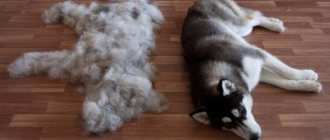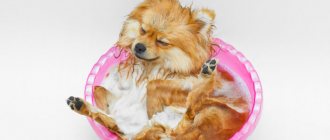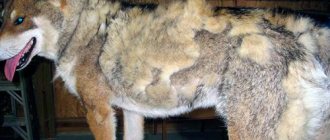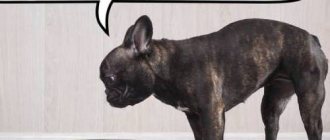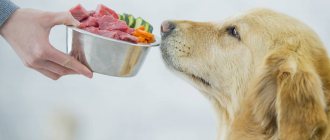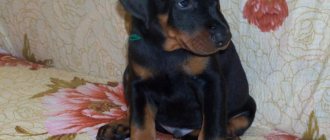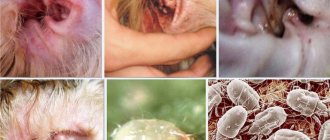What is shedding and why does a dog need it?
Thanks to the renewal of the hair coat, the dog prepares for weather changes, acquiring a thinned coat with a predominance of guard hairs before summer, and a thick and dense undercoat before winter.
At the same time, the length of the vegetation does not at all affect its tendency to fall out. It is so laid down by nature that damaged and thinned old wool, having fulfilled its insulating function, gives way to new one.
Like any cyclical physiological process, molting cannot be canceled or delayed. To understand the inevitability of shedding, you need to understand why the dog was given fur in the first place. In addition to exceptional external advantages and protection from adverse climatic conditions, it is required to regulate body temperature.
The owner can help the pet by promptly removing dead hair and tangles (in the case of some breeds, the concept “promptly” should be read as “daily and year-round”).
Treatment
Shedding cannot be stopped overnight. The owner of the animal must take a whole range of measures in order to alleviate the condition of his pet. Based on the diagnosis, the veterinarian will prescribe treatment that must be followed. Treatment directly depends on the cause that caused such processes in the body.
Hormonal disorders
Hormonal problems are treated by taking estrogens and androgens in minimal proportions. The doctor independently sets the dosage and duration of administration. Every 90 days, the doctor will monitor the health status of his patient. Chloditan is also prescribed 50 ml daily for 2 weeks. Later, the doctor decides to reduce the dose. In some situations, the patient may be prescribed Lugol's solution from 5 to 10 drops.
Lugol's solution
Decreased immunity
Drugs that have a detoxifying effect help to effectively cope with this problem. They increase the body's resistance to stress and stress. The following immunostimulants are offered for dogs:
- Maxidin;
- Glycopene;
- Immunofan;
- Ribotan.
Ribotan
The duration of the course and dosage are prescribed only by the attending veterinarian. Dogs can also be prescribed vitamins in tablet form. Vitamins are given to dogs crushed or dissolved in food. Vitamins should contain the following substances:
- vitamins A, B;
- a nicotinic acid;
- ascorbic acid;
- B5;
- iodine;
- zinc;
- selenium;
- iron.
Kidney failure
Kidney failure, depending on the stage of development of the disease, is treated in several ways:
- antibiotics (Amoxicillin and Biseptol);
- diuretics such as Furosemide;
- drugs containing potassium (Asparkam);
- drugs that eliminate putrefactive processes (Vitom and Lactusan);
- antispasmodics (No-shpa and Papaverine).
It is important to identify renal failure early before severe consequences occur.
Parasitic infestations
If dogs have parasites, the following anthelmintics are prescribed:
- Azinox;
- Azinox plus;
- Dirofen;
- Transit;
- Holiday plus.
Anti-worming medications for dogs
As a rule, as soon as the parasites are destroyed, the hair begins to recover. It is recommended to follow diet and hygiene rules to ensure that animals do not become infected again.
Video - How to deal with shedding
How many times a year does a dog normally shed heavily and at what time?
The puppy exchanges baby fluff for the first fur at the age of about 2 months, and this in turn - at 6 months - for the adult coat.
If we are talking about an adult dog and a seasonal change in hair, it is supposed to shed twice a year: in spring and autumn for about 2-3 weeks. After all, nature has determined that the dog will sleep in the snow in cold weather thanks to its powerful undercoat, and in hot weather it will not mind the bright sun, since its long and strong awn will protect it from heat stroke.
And that is why, sometimes, the body of a dog living in a greenhouse apartment becomes slightly perplexed. An animal that goes outside for half an hour a day does not feel climate changes and begins to shed little by little all year round.
Some dog breeders call this a funny word, “shedding.”
Dog Breeds That Don't Shed
If you are considering getting a pet, but are worried about dirt or are prone to fur allergies, consider dog breeds that are odorless and shedding free. Among them:
- miniature, standard and toy poodle;
- varieties of terriers (Kerry Blue, Border, Yorkshire, Wheaten);
- African non-barking dog;
- lion dog (Shih Tzu);
- hairless crested;
- Mexican hairless breed.
These are just some of the breeds. Many representatives of the selection do not have an unpleasant odor or excess fur. Otherwise, you know what to do if your dog sheds. Proper care will allow you to pass this period quickly and with minimal discomfort.
When and for how long does the coat change?
Autumn shedding is long-lasting, since its task is to build up a thick undercoat. It begins before frost (it is difficult to name exact dates; it depends on the climate zone and current weather conditions) and can last up to one and a half months. After the autumn molt, the pet seems more voluminous and fluffy.
The spring coat change, on the contrary, is characterized by a rapid shedding of winter fluff and therefore lasts significantly less: 1-2 weeks. It begins as soon as it stops being frosty at night (again, here you need to look not at the calendar, but at the thermometer).
How does a dog's behavior change when shedding?
When dogs begin to shed, new habits develop. They rub against various objects, are more affectionate towards their owners, and itch on the grass and ground during walks. This is how they try to get rid of the “fur coat” that gets in the way. Unpleasant sensations make them more irritable and aggressive.
At home, this behavior causes discomfort. Wool ends up everywhere and the furniture has to be cleaned constantly. To make life easier for your dog and yourself, follow these tips for caring for your pet during a coat change.
Features of shedding by breed
In long-haired
Long-haired dogs are prone to matting. The rich fur coat, consisting of long guard hairs and an impressive undercoat, requires daily brushing during shedding (the result can be a mountain of fluff equal in size to the dog itself).
Moreover, furry pets need to be cut and bathed at least once every 2 weeks. Neglecting this recommendation can lead to matted, unaesthetic tufts that cause irritation on the skin. And parasites, in turn, easily penetrate the wounds. By the way, we have an excellent article about choosing the best drops for fleas and parasites in dogs.
In shorthaired
Smooth-haired dogs shed just as actively as their long-haired relatives, but this process is not as noticeable. But the results of shedding are clearly visible indoors, where short bristles are scattered in large quantities in the corners and baseboards.
The group of short-haired dogs includes many Molossians, Dalmatians, Dobermans, Dachshunds and other owners of needle-haired dogs. Representatives of these breeds are recommended to be brushed with a natural bristle brush, and also wiped twice a day with a terry towel or velor cloth that collects hairs.
In wire-haired
Wire-haired dogs, which include terriers and schnauzers, require specialized help from a groomer. Every six months they need to be taken for trimming (plucking by hand or using hairdressing tools). This requirement is due to the fact that the hard coat itself hardly falls out when shedding, but changing it untimely can cause problems for the dog.
The pet, feeling the need to shed old hair, begins to actively itch, damages the skin and opens the gates for infection.
Breeds that don't shed
Breeds that do not shed hair include, firstly, those that are not endowed with fur: the Xolo, the Chinese Crested Dog and the Peruvian Hairless Dog.
Many people believe that Basenjis and poodles do not shed, but in the first case, short light bristles are simply unnoticeable in the interior, and in the second, the hair gets tangled in curls and does not fall to the floor, although the hair follicles leave the skin and fall off like felt.
By analogy, we can recall the Komondor (a dog with dreadlocks, similar to a giant mop): his long curls, tangled in cords, continue to hang, although most of the hair in them has already fallen out.
Secondly, non-shedding breeds often include dogs whose hair is more reminiscent of long human hair: Afghan hounds and Yorkshire terriers. These sophisticated creatures have virtually no undercoat; their coat consists mainly of awns. Therefore, seasonal shedding is not relevant for them (after all, in the standard case, the dog grows undercoat in the fall and sheds it in the spring).
Important! Even the absence of a hint of vegetation does not guarantee that the owner will not be allergic to the pet. After all, in addition to the fluff itself, any animal has dandruff, which can become a powerful trigger.
Moreover, a person can begin to react to dust particles from dry food, and even to saliva protein or dog sweat, no matter how funny it may sound. And if the dog brings ticks in his symbolic fluff, the sensitive owner will be in doubly bad luck (asthmatics can react especially sharply).
Are there any special products against heavy shedding?
You can stop heavy shedding in dogs with the help of complex vitamins and nutritional supplements. If this does not help, then you need to contact a veterinarian, who, after an examination, will make a decision and tell you how to help the animal.
What is express molting, reviews and prices
REFERENCE! Express shedding is a professional combing performed by a master in a pet salon. It is especially effective during seasonal shedding, but it can also be performed at any time on animals that live indoors and shed year-round.
Of course, every owner in the house or in the yard can comb his dog, but not everyone knows how to do it correctly, they don’t know how to comb it correctly during shedding and how to handle the tool and the animal. The result of improper handling can be skin damage of varying degrees of complexity, torn hair and stress in the dog. In addition, not everyone has the time and desire to comb, or there may be another reason - someone in the family is allergic to dog hair. With express shedding performed by a professional, all this can be avoided.
How is express molting done? The master places the animal on the table and combs it with a furminator brush. Then the animal is bathed with shampoo and mask and the hair is dried with a special hairdryer. With these procedures, almost 90% of unnecessary fur is immediately removed, revealing a brand new shiny coat. Thanks to quick combing, the pet looks well-groomed and hair no longer lies all over the house, which, according to dog owners, is the main advantage of the procedure. The effect of express shedding lasts for 2–3 months. The price for this depends on the size of the dog, the thickness and length of its coat. Express shedding is not carried out at home; it is done only in specialized salons.
How can the owner help the dog?
The owner can help the pet survive the molting painlessly, so that the animal does not scratch all its skin and does not remain in tangles.
If your pet doesn’t have suspicious rashes, scabs or visible damage, he doesn’t comb the same places and there are no visible bald spots, all you have to do is wait until the dog gets a new head of hair that will be the envy of everyone.
And, of course, the owner must understand whether the dog sheds more often and longer than expected.
In certain cases, constant, rather than seasonal, shedding can signal possible ill health. You need to evaluate whether a lot of hair is being shed, and if it is shedding in minimal amounts, then there is nothing to worry about.
But if in doubt, you can contact your veterinarian to rule out the following conditions:
- allergic skin rashes;
- presence of parasites;
- hormonal disbalance;
- stress;
- yeast dermatitis or bacterial disease;
- incorrect temperature conditions (when the room is more than 25 degrees, this is harmful not only for the beauty of the fur, but also for the heart).
In addition to the reasons listed, it is easy to assume pregnancy in females, during and after which increased hair loss is also likely.
Neutered shorthaired females, on the other hand, often shed year-round, but little by little.
Also, the answer may lie in insufficient or inappropriate nutrition: this condition is often the result of a food allergy, when the dog furiously scratches the skin and rips fur out of it.
For an owner who wants to understand the unnaturally long and intense shedding of a pet, the veterinarian may recommend an examination with a visual examination, trichoscopy, cytological examination, scraping and blood tests.
What tools and combs are needed
- Using combs with moving teeth and slicker brushes, the owner collects loose hairs before they fall to the floor. You need to comb in the direction of hair growth (towards the ends), but without pressing or scratching the skin. The fur should be dry and clean, and there should be no damage to the skin.
Important! Grooming tools in inept hands can scratch the animal, and no one will like the process of tearing out tufts. Therefore, the animal may be dissatisfied with the daily use of a slicker brush and a sharp comb.
- When using a furminator, the owner does not scratch the pet or tear out healthy fur. According to groomers, this tool reduces shedding by more than half. But there are also disadvantages: it is not cheap and cannot be used on damaged skin.
- Fine and short hair requires frequent combing with closely spaced teeth. This device removes dirt and parasites well.
- For short-haired dogs, soft brushes made of natural bristles and terry towels are recommended to remove loose hairs. You can also use massage mittens.
- In advanced cases, a tangle cutter may be useful: vertical, horizontal and drop-shaped.
- An alternative to a mat cutter is a clipper.
- The trimming knife is suitable for terriers and schnauzers. This device catches old bristles and painlessly removes them from the hard coat.
How to brush a dog: frequency of brushing
Dead hairs are removed with brushes and slickers. If there are damaged areas on the skin, it is better to do without brushes. The tool should be guided from roots to ends, pressing the hair towards the body without force.
Trying not to damage the skin, you need to brush with a leisurely movement and repeat this procedure 1-2 times a day.
Nutrition and vitamins
- B vitamins are a traditional recommendation. It cannot be said that they stimulate shedding, but they certainly have a beneficial effect on the condition of the renewed coat.
- It is often recommended to take brewer's yeast (preferably in the form of ready-made supplements).
- Fish oil also improves the condition of the hair.
It is important not to exceed the dosage, especially in the case of vitamins, since B-hypervitaminosis can lead to allergies. Only skin problems during the period of prolonged molting were not enough!
Proper and expensive food that ensures rapid coat change must contain a sufficient amount of protein, which gives strength and shine to the hair. During shedding, it is also recommended to give your pet raw offal. We also recommend reading about Holistic food for dogs.
Is bathing necessary?
- By purchasing special shampoos to renew the coat, you can notice improvements in the quality of the hair: it becomes more shiny, and the amount of dandruff decreases. But the main purpose of such a shampoo is to stimulate hair change: thanks to them, the old hair falls out even faster.
- Some groomers recommend using anti-shedding sprays that strengthen hair. These cosmetics act opposite to shampoos, maximizing fur improvement and preventing hair loss.
As for the need for water treatments, you need to look at the breed of your pet, since for some of them monthly bathing is contraindicated.
Why does a dog shed in winter even though it lives outside?
In winter, the dog should not shed. This indicates that not everything is okay with the pet. There are many reasons why hair loss occurs in winter.
Reasons for shedding in winter:
- You took the passer into a warm room. The animal’s body reacted quickly, and the dog gradually gets used to the new warm conditions. Even in severe frosts, dog breeders do not recommend taking your dog home.
- Bad food. Perhaps you gave your dog new foods to try or purchased new food. Animals are very sensitive to changes in feeding.
- Allergy. Think about purchasing a new shampoo or introducing new vitamins into your dog's diet. This may cause allergies.
- Stress. Perhaps the dog got into a fight or you yelled at it for something. Stressful situations immediately affect the condition of the dog's coat.
- Vlasoed. This is a nightmare for seasoned dog owners. This parasite eats fur and in severe cases the dog can remain completely bald. The disease is difficult to diagnose.
Why does a dog shed in winter even though it lives outside?
Pathological cases requiring treatment by a veterinarian
If a pet falls ill, an attentive owner will definitely note uncharacteristic details of his condition.
Here is a list of symptoms that require urgent medical attention:
- apathy,
- refusal of food,
- diarrhea and vomiting,
- temperature increase,
- skin problems,
- itching,
- unnatural smell.
In these cases, hair loss is only a consequence of problems with well-being, and you cannot delay a visit to the doctor.
Hormonal disbalance
Most often, hormonal imbalance refers to hypothyroidism (insufficient functioning of the thyroid gland). In this case, the dog will go bald gradually, but over a large area and symmetrically. The matter is not limited to baldness; this problem is usually accompanied by bradycardia and the appearance of age spots. Treatment consists of taking synthetic medications intended for the thyroid gland.
With an excess of cortisol, a large amount of hair loss also occurs, while the dog experiences extreme thirst, urinates frequently and quickly loses weight. Treatment is aimed at suppressing cortisol production.
Hyper- and hypoestrogenism are associated with an excess or deficiency of estrogen. In the first case, both sexes can be affected by the disease, and the issue is resolved by surgery. In the second case, middle-aged ladies usually suffer, and therapy consists of taking hormonal pills.
Parasite infestation
When a pet is attacked by parasites, it is difficult to make a mistake: fleas often bite the owner himself, and they themselves and traces of their vital activity are visible to the naked eye. In this case, the dog itches furiously and gnaws its fur, its skin becomes covered with small ulcers. With demodicosis, the pet may become almost completely bald, and the skin will be noticeably sore. Fortunately, there are dozens of topical medications against blood-sucking insects.
Food allergies
It happens that ready-made food or several components in a natural diet are not suitable for a dog. The consequence will be that the dog will begin to constantly itch and tear out its fur. In addition to minor wounds, you can pay attention to rashes and conjunctivitis. The doctor will most likely prescribe a food review, as well as antihistamines and antibiotics.
Yeast or bacterial infection
With trichophytosis, microsporia and ringworm, hair loss and peeling of the skin, inflammation, and the presence of purulent wounds are observed. Pyoderma and abscesses look similar, with the skin looking like sandpaper and developing ulcers. In both cases, antibiotics and medications are prescribed to relieve symptoms.
Lack of micro- and macroelements
Hypovitaminosis is not as dangerous as hypervitaminosis (the consequences of which can be treated for several months, so you need to be careful about the dosage). But this condition is also characterized by a number of problems: partial baldness, itching, lightening of the mucous membrane and low temperature. This is basically how vitamin A and B vitamin deficiency manifests itself.
When to see a doctor?
You should consult a doctor if you notice at least two of the above symptoms in your animal. If this is your first time encountering seasonal shedding and you don’t know how to behave in such situations, you should also consult a veterinarian.
Diagnostics
A doctor cannot draw a conclusion about a disease based on just one visit. Spare no expense, go to a good clinic. You will undergo a step-by-step diagnosis, the result of which will be a diagnosis. After this, you can begin treatment.
Table 1. Stages of diagnosing a dog
| Stage | Description |
| Inspection | Diagnosis begins with a general examination of the dog. The doctor checks the condition of the skin, reactions, and painful pressure. Other external signs that may indicate the disease are also recorded. |
| Laboratory research | After the examination, the doctor suggests taking blood tests, which will rule out problems with the liver or pancreas. |
| Additional Research | If the tests show a negative result for the presence of problems, it is necessary to take a scraping and an allergy test in order to determine the possibility of developing skin diseases |
| Conclusion | Based on the data received, the doctor tells you the diagnosis |
Only a veterinarian can determine the exact cause.
Prevention of excessive hair loss in dogs
In order for hair loss to be natural and physiological, limited to seasonal changes, you need to remove allergens from food, select vitamins and high-quality food, treat the dog with anti-parasite drugs, comb it regularly, and use a suitable shampoo when bathing.
Any symptoms associated with hair loss should be noted and shown to a veterinarian because they may only be the visible part of the iceberg and signal a health problem.
Tools for combing wool
To carefully comb out loose hair and painlessly remove formed tangles, there are various devices:
- comb made of hardened steel, the best option is nickel plated. This tool is most often used for grooming the undercoat;
- slicker This brush is suitable for sensitive dogs who cannot tolerate a metal comb. She carefully and delicately combs out the accumulated hair;
- A glove brush is used to comb out and collect dead hairs. It fits comfortably on your hand and effectively removes hair;
- The furminator is a modern tool that can replace all of the above devices. The Furminator is similar to a comb, but has a steel blade with teeth and a comfortable rubber handle. Thanks to the slotted blade, the undercoat is easily removed from the coat without damaging living hairs.
Important: you cannot use the furminator if there are irritations, sores, wounds or similar damage on the animal’s skin. Also, the use of the device is not allowed if the dog has mats. In this case, they must be carefully removed in advance so that the furminator does not cause pain to the animal.
Regular brushing of your dog will prevent hair from settling on the furniture and floor. The most convenient way to deal with hair is to place your pet on newspaper or cellophane. This will help you remove lost hair very quickly.
What to feed and vitamins
To reduce the negative effects of factors that provoke hair loss, you need to take care of nutrition. Often at this time, animals’ mood deteriorates and their appetite is lost, so special care is needed.
When choosing a diet, you need to take into account the characteristics of the pet’s breed, what foods are allowed and prohibited. It is also advisable to remember the dog’s own preferences. The basis of the diet should be meat, accompanied by nutritious cereals: millet, wheat, buckwheat. Several times a week you need to cook fish and offal.
To compensate for the deficiency of useful microelements, it is recommended to give anti-molting vitamins. An excellent alternative would be fresh vegetables and fruits, but only if the pet eats them voluntarily. If necessary, your veterinarian will help you choose the appropriate vitamin complex.
Prevention
How to protect your beloved pet from unscheduled shedding? This question is often asked by dog owners. After all, you want your four-legged friend to always be cheerful and healthy. For this, constant care and attention is important.
- Routine visit to the veterinarian.
Often, only an experienced specialist can replace the disease in the early stages, which will allow your pet to be quickly cured.
- Systematic inspection of the animal's home.
It is important to check whether the animal has parasites and whether the condition of its skin, fur, teeth and gums is normal.
- Taking vitamins and proper nutrition.
Make sure that your pet eats regularly and only fresh food intended for its age and breed.
- Regular washing and combing of wool.
Still, you should not bathe your dog too often, but it is also undesirable to neglect hygiene.
- Peace.
Any stress causes irreparable damage to the animal’s psyche. Try to avoid this.
- Walks in the open air.
Walk your dog every day, even in bad weather. But be careful - do not allow the animal to overheat or hypothermia.
So, it is very important to monitor the condition of your pet and help him not only during periods of stress, but also to provide proper prevention. A dog is not only a source of joy, but also a great responsibility.
Why Wool May Look Bad
As a rule, a dog sheds constantly for various reasons. But this shedding is preceded by a change in the condition of the coat. So, initially the dog’s fur may become dull and hard, and only then the hairs will begin to fall out.
This can happen for a number of reasons:
- Poor, unbalanced or irregular diet.
- Diseases of the gastrointestinal tract.
- Kidney diseases.
- Decreased immunity.
- The appearance of parasites in the animal's body.
Hair loss is a consequence of the appearance of such factors. When the disease has already been cured, many owners observe that the dog still sheds heavily. What to do in this case? Nothing, wait a certain time. Due to the stress experienced, shedding may continue for several months after treatment.
Additional warning symptoms
If molting is caused by pathologies, then, in addition to the main symptom, additional alarming symptoms are often observed. The clinical picture depends on the disease or dysfunction of the body. Common manifestations: dandruff, scratching, redness, sores and bald spots.
Dandruff
During the shedding of old fur, dandruff often appears. These are dead particles of the upper layer of the epidermis. In appearance they resemble small dots or flakes. Causes:
- dry skin - occurs due to temperature changes in the room or the use of inappropriate care products that remove the fat layer;
- ectoparasites (ticks, fleas) – additionally cause itching;
- dietary errors, allergies to certain products or components;
- symptom of disease - dermatitis, eczema, diabetes;
- stress factors.
If the reasons are shedding, then there is no need to fight dandruff. Symptoms will disappear when the hair stops falling out. If the itching is too severe, the doctor will prescribe vitamin and mineral preparations in the form of injections. If a disease is detected, treatment is carried out according to a standard scheme, taking into account the symptoms.
Remember! Dandruff is not a disease, but a symptom. Therefore, after the first detection, you need to immediately contact a veterinarian. This will help you quickly determine the cause, preventing the development of the disease and complications.
Combs
When hair loss occurs, scratching appears due to itching, which is caused by various factors. The main problem is parasites. The scabies mite (itching) is dangerous for pets, causing the development of sarcoptic mange and ear scabies. Other diseases or pathologies that lead to scratching: allergies, seborrhea, ringworm, yeast infection, worms.
Skin sores
Prolonged scratching leads to sores appearing on the skin. The reason is skin lesions of various origins. Diseases: eczema, ectoparasites, infections, fungus, allergies, metabolic disorders and hormonal imbalances. Usually dogs gnaw the skin until it bleeds, resulting in the formation of crusts and ulcers. Sores may appear for other reasons. To find out, a mandatory consultation with a veterinarian is required.
What is this
Animal hair is significantly different from the hair that grows on the human body. Of course, each dog breed has its own unique hair characteristics. But they all have one thing in common - the cyclical nature of hair growth and loss. A dog's fur does not grow continuously. After the so-called rest period, the dog begins to rapidly grow hair. After some time, this fur dies and is shed. Moreover, during molting, almost all the hair on the animal’s body is renewed.
After this, the hair begins a new cycle - it begins to grow again. This period lasts on average 130-140 days .
The onset and duration of shedding depends on whether the dog is in its native climate. For example, a husky living in the north never sheds sharply, but changes its hair coat constantly throughout the year. A dog of the same breed living in the central zone sheds its hair like other dogs - twice a year.
Dog fur is divided into three types:
- Tactile is a mustache, eyebrows and short hairs in the ears.
- The guard coat is a hard coat that provides protection from moisture, parasites and serves to camouflage the animal.
- Undercoat - helps maintain proper body temperature, protects from cold and moisture.
Depending on the temperature outside the window, a more intensive renewal of one of them occurs.
Normally, dogs shed in spring and early fall and last one to two weeks. But there are a number of additions to this rule:
- Long-haired dogs (for example, breeds such as Afghan Hound, South Russian Shepherd) need brushing all year round, regardless of the season. Their outer layer of fur changes continuously.
- Bitches begin to shed unexpectedly during the period of estrus. Usually it is shorter lasting, but quite intense.
- Typically, females shed more than males.
- A dog may shed a lot if it suddenly moves to a hot climate.
- In dogs with thick undercoat, the shedding period can last up to 3-3.5 weeks. The fact is that first the dog sheds part of the outer layer, and only then the undercoat sheds.
There are also dogs that don't shed. It is important to purchase such dogs from experienced and trusted breeders, because this property is traceable by pedigree. But you shouldn’t expect that you will never find hair in the house - after all, occasionally, the hair of such dogs falls out. These breeds include: Poodle, Chinese Crested, Miniature Schnauzer, Giant Schnauzer, Fox Terrier, Airedale Terrier, Yorkshire Terrier, White, Scotch, Boston and Staffordshire Terriers, Brussels Griffon, Bichon Frize, Basenji.
Age-related molting
Another natural process is age-related molting, which is associated with changes in the animal’s hormonal levels. It differs from seasonal molting in that it is not tied to a specific period, but can occur at a certain age.
Puppies develop their adult coat, the junior period, so to speak, but age-related shedding can also occur in older pets. In such dogs, metabolic processes change, which can delay shedding for a year or longer. Very old pupils are prescribed a special vitamin complex, which accelerates the growth of new hairs.
